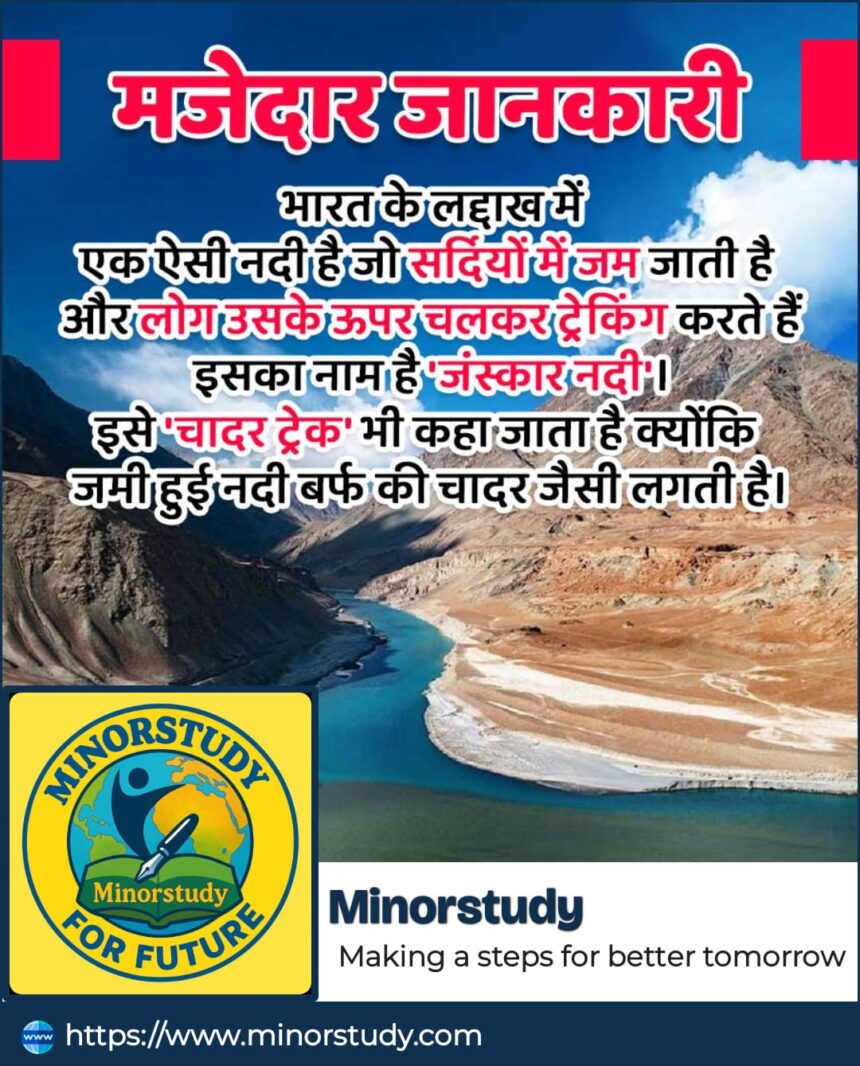🧊 Zanskar River & the Chadar Trek: A Frozen Wonder of India
Have you ever imagined walking on a frozen river in the middle of the Himalayas? Welcome to the magical world of the Zanskar River, where winter turns water into a crystal carpet and trekkers become pilgrims on ice. This surreal journey is known as the Chadar Trek, one of India’s most iconic, extreme, and soul-stirring adventures.
- ❄️ What is the Zanskar River?
- 🧊 What is the Chadar Trek?
- 📜 History of the Zanskar River & Chadar Trek
- 📌 7 Mind-Blowing Facts About Zanskar River & Chadar Trek
- 1. You’re Literally Walking on a Frozen River
- 2. One of the Coldest Treks on Earth
- 3. Used by Local Schoolchildren
- 4. Temporary Caves as Night Shelters
- 5. Environmentally Fragile and Threatened
- 6. Part of Ancient Buddhist Trade Route
- 7. Declared One of India’s Most Dangerous Treks
- 📅 Timeline of Events
- 🌍 Cultural and Environmental Significance
- 🙏 Wishing for a Safe, Soulful Trek
- ❓ FAQs
- 🧭 Importance in Life & Society
- 💫 Teaches Patience and Simplicity
- 🧑🤝🧑 Promotes Indigenous Knowledge
- 🌿 Inspires Environmental Awareness
- 🎯 Key Takeaways
- ✅ Conclusion: An Icy Trail to the Warmest Lessons in Life
In this human-centric and warm article, we’ll explore everything about the Zanskar River and the Chadar Trek—its history, timeline, facts, FAQs, significance, rituals, impact on daily life, environmental importance, and a lot more, all in over 1200+ words.
So, zip up your winter jacket and step into a tale of ice, survival, heritage, and breathtaking beauty.
❄️ What is the Zanskar River?
The Zanskar River is a north-flowing tributary of the Indus River located in the Union Territory of Ladakh, India. It flows through the Zanskar Valley, a remote and rugged terrain known for its Buddhist monasteries, high-altitude villages, and deep gorges.
Length: ~150 km
Origin: Near the Pensi La Pass, from the glaciers of the Doda and Lungnak Rivers
Confluence: Meets the Indus River near Nimmu, close to Leh
During summer, the river is a torrent of blue-green water used for white-water rafting. But in winter (January–February), it freezes over, forming a thick sheet of ice or “Chadar”, hence the name Chadar Trek.
🧊 What is the Chadar Trek?
The Chadar Trek is a 90-105 km (round trip) trek on the frozen Zanskar River, starting from Chilling village to the Zanskar Valley (Nerak and beyond). Temperatures drop to -25°C to -35°C, and trekkers walk, slip, and slide across the icy surface.
Duration: 7–9 days
Best Time: Mid-January to mid-February
Altitude: 11,000 ft (approx.)
It’s not just a trek, but a winter pilgrimage—a living connection to ancient paths once used by locals to travel during the blocked winter months.
📜 History of the Zanskar River & Chadar Trek
Before it became a famous adventure destination, Chadar Trek was a lifeline for the people of Zanskar Valley:
Zanskar remains cut off from the rest of Ladakh in winter due to heavy snow.
Locals used the frozen Zanskar River as a path to transport goods, reach markets, schools, and hospitals in Leh.
This winter journey was more necessity than sport—a testimony to human resilience.
The word ‘Chadar’ means blanket in Hindi—symbolizing the icy sheet covering the river, while Zanskar is derived from the Sanskrit words “Zang” (white) and “Kar” (ice/snow).
📌 7 Mind-Blowing Facts About Zanskar River & Chadar Trek
1. You’re Literally Walking on a Frozen River
Unlike most treks on land, here you’re trekking directly over a river! It’s not a snow trail or a glacier—it’s a flowing river that turns into an icy highway.
2. One of the Coldest Treks on Earth
Temperatures drop below -30°C, often requiring double thermal layering, waterproof shoes, and oxygen monitoring.
3. Used by Local Schoolchildren
Children from Zanskar have walked the Chadar route to reach schools in Leh, walking for days in harsh conditions—a true story of determination.
4. Temporary Caves as Night Shelters
Trekkers and locals rest in natural caves formed along the cliffs, warmed by small fires and insulated with mats.
5. Environmentally Fragile and Threatened
The trek route is sensitive to global warming, pollution, and river hydroelectric projects. In recent years, part of the river has stopped freezing properly.
6. Part of Ancient Buddhist Trade Route
Zanskar is dotted with monasteries like Phugtal and Karsha, built on cliffs overlooking the river—used by monks and traders centuries ago.
7. Declared One of India’s Most Dangerous Treks
Despite its beauty, Chadar Trek is risky, with ice cracks, snowstorms, and freezing injuries. However, the spiritual and natural reward is unmatched.
📅 Timeline of Events
| Year | Event |
|---|---|
| Ancient Times | Used by monks and villagers as trade & travel route in winter |
| 1970s–80s | Recognized by adventurers as a high-risk winter trek |
| 1990s | Featured in National Geographic and international documentaries |
| 2010s | Gained popularity among trekkers and Indian youth |
| 2018–Present | Environmentalists began raising concerns about climate change, banning plastic, limiting trekkers per season |
🌍 Cultural and Environmental Significance
🧘 Spiritual Value
Zanskar Valley is home to ancient Tibetan Buddhism.
Locals often consider the Chadar Trek a spiritual journey, full of challenges, silence, and surrender.
🏔️ Environmental Concern
The fragile eco-system is under threat from:
Hydroelectric dam construction
Melting glaciers
Rising tourist waste
Authorities and NGOs are working to:
Limit plastic usage
Impose strict guidelines for trekkers
Train local guides for eco-awareness
🙏 Wishing for a Safe, Soulful Trek
💙 “Wishing all adventurers the courage, calm, and clarity that the Chadar Trek offers.”
💙 “May the Zanskar River’s frozen beauty reflect inner stillness and strength.”
💙 “Respect the land, respect the ice, and walk with humility—this isn’t just a trek, it’s a teacher.”
❓ FAQs
Q1. Is Chadar Trek suitable for beginners?
No. It’s a high-risk trek that requires physical fitness, mental endurance, and extreme cold preparedness.
Q2. What permits are needed?
You’ll need:
Medical Certificate
Wildlife Permit
Trekking Permit from the DC office in Leh
Q3. Is it still safe to do the Chadar Trek?
Yes, but only under registered agencies. Be aware of climate-related unpredictability.
Q4. Why is it so popular despite the danger?
Because of its raw beauty, remote terrain, and spiritual challenge—it’s an unforgettable life experience.
Q5. Are there alternative treks in Zanskar?
Yes, in summer: Padum-Darcha Trek, Lamayuru-Padum Trek, and Markha Valley.
🧭 Importance in Life & Society
💫 Teaches Patience and Simplicity
Trekking on a frozen river for days shows us the value of slow progress, humility, and trust in nature.
🧑🤝🧑 Promotes Indigenous Knowledge
Local Zanskari people act as guides, sharing their ancestral survival skills and cultural wisdom.
🌿 Inspires Environmental Awareness
When walking on ice that could melt in the next decade, one understands the urgency of climate action.
🎯 Key Takeaways
The Zanskar River and Chadar Trek are not just tourist spots—they are living legends.
As climate change threatens the future of Chadar Trek, your awareness, respect, and responsibility matter.
If you ever walk this icy path, walk gently, mindfully, and gratefully.
✅ Conclusion: An Icy Trail to the Warmest Lessons in Life
The Chadar Trek over Zanskar River is more than an adventure—it’s a rite of passage, an invitation to humility, and a reminder that nature is both mighty and fragile.
Whether you’re planning to go or just reading about it today—know that India holds within it such miracles that inspire awe, courage, and change.
💙 Walk wisely. Respect deeply. Trek consciously.








